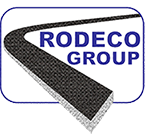DESCRIPTION
6D Solutions fiber glass grid id an interlayer reinforcement material: it can be placed between the old asphalt and the new overlay because it retards the cracking of the new surface by dissipating the horizontal stresses induced by the cracks. The grid is strong (Young’s modulus of approximately 50 GPa) and flexible, thermally stable at asphalt laying temperature of about 200°C, having a high tensile strenght.
The grid is impregnated by a resin, in order to allow higher compatibility and adhesion with asphalt, longer-lasting mechanical performance and protection against various chemicals and abrasive materials.
The grid is impregnated by a resin, in order to allow higher compatibility and adhesion with asphalt, longer-lasting mechanical performance and protection against various chemicals and abrasive materials.
It has a square open mesh form, 40 mm x 40 mm, that facilitates aggregate interlock between paving courses, restrains lateral movement of the aggregates, enhances through-hole bearing capacity and allows more stress to transfer to the grid by means of the interlocking aggregates of the asphalt layers.
6D grids are associated with a light polyester nonwoven (about 20 g/m²): it acts as an interface between the tack coat and the tires of vehicles during construction. It can absorb an excess of binder of the tack coat and help to better distribute it, because an excess of binder can lead to problems during construction. The emulsion may stick to construction vehicle tires and lead to detachment of the grid from the underlying layer. An insufficient quantity of emulsion indeed leads to improper functioning of the interlayer due to delamination by poor bonding. Moreover, the light polyester non-woven allows aggregates of the asphalt mixtures to pass through easily and thus ensures aggregate interlocking between layers.
About the tack coat, Impregnation capacity of tack coat usually applied is minimum 600 g/m² of residual bitumen. This quantity has to be adapted regarding the characteristics of the support layer; the bond must be checked by the end user.
6D grids act principally as a reinforcement interlayer system helping to delay reflective cracking; this reinforcement mechanism is the following:
- The crack starts to propagate (due to thermal and traffic loading or uneven soil movements) from its original position upward until it reaches the reinforcement layer;
- If the interlayer is stiff enough (stiffer than the surrounding materials), the crack will turn laterally and move along the interface until its energy is exhausted;
- Based on this mechanism, the 6D grids contribute to the structural capacity of the pavement.
TECHNICAL SPECIFICATION (for 100 KN/m type)
| Mechanical strength | at break | at 1% elongation | at 2% elongation |
| Long direction | 100 KN/m | 35 KN/m | 70 KN/m |
| Cross direction | 100 KN/m | 35 KN/m | 70 KN/m |
| Elongation | At break |
| Long direction | < 3 + 0.5% |
| Cross direction | < 3 + 0.5% |
APPLICATION
For installation procedures, technicians have to follow these recommendations:
- Surface preparation: glass fiber grid must be placed on a smooth, level, clean and dry surface. Any surface that is not finely milled may require a levelling course of about 20 to 50 mm. Potholes and open cracks must be treated prior to grid installation.
- Placement of grid: the surface of the grid must be rolled with a rubber-coated or pneumatic tired roller to improve bonding.
- Tack coat with modificed bitumen is recommended for promoting stronger interface bonding. Tack coat must cure before placing the asphalt overlay;
- Use of filler is recommended only if the tires of the vehicles, during the asphalt laying, detach the grid from its support;
- Place manually the bitumen emulsion on the overlapping of two different grid roll or when the grid is cutted (for example on a cuve or a roundabout).


